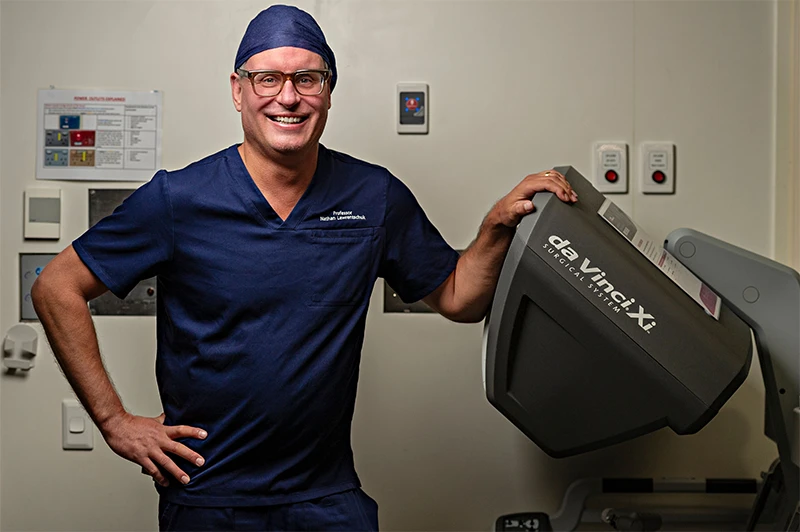Retroperitoneal Lymph Node Dissection (RPLND) is a surgical procedure to remove lymph nodes from the back of the abdomen (retroperitoneum) where testicular cancer commonly spreads.
What does ‘robotic’ mean?
Prof Lawrentschuk performs this surgery using the da Vinci robotic system, which provides enhanced precision, visual clarity, and control. It is important to note that the robotic system does not operate autonomously; all movements are directed entirely by Prof Lawrentschuk from a console.
The benefits of robotic surgery include:
- Smaller incisions
- Reduced bleeding and postoperative pain
- Shorter hospital stay
- Faster recovery time
- Lower risk of infection
Why is RPLND required?
Retroperitoneal Lymph Node Dissection is recommended to:
- Remove cancerous lymph nodes and reduce the risk of cancer spreading
- Provide accurate staging of the cancer
- Treat residual lymph node masses after chemotherapy
It plays a crucial role in both diagnosis and treatment of testicular cancer and may lead to a cure without additional therapy in some cases.
Before surgery
You will be contacted 1–2 weeks prior to your scheduled procedure with specific fasting instructions and hospital admission details. You will also receive a link to complete your online admission forms.
It is important to advise the rooms if you are taking any blood thinners or any prescribed medications for diabetes or weight loss purposes. The rooms can be contacted on 9329 1197
During surgery
The procedure is performed under general anaesthesia or a spinal anaesthesia. It consists of the following steps:
- Several small incisions are made in the abdomen.
- A robotic system is used to insert a camera and instruments through these incisions.
- Prof Lawrentschuk controls the robotic arms from a console, providing enhanced dexterity and a 3D magnified view.
- Lymph nodes in the retroperitoneum are carefully dissected, removed and sent for pathology testing.
The procedure may take longer than open RPLND (completion of procedure without robotic instruments) due to setup and precision steps, but usually results in shorter hospital stays and less post-operative pain.
Following surgery
Hospital stay
You will be admitted on the day of your surgery, with a typical hospital stay lasting 3-5 nights. Post- operatively, patients may spend the first night or longer in the Intensive Care Unit (ICU). Please note that:
- Normal eating is usually delayed for several days due to bowel inactivity (ileus), which can take up to a week to resolve.
- Pain at the incision sites is common but is usually well-managed with medication.
Recovery at home
Once at home, please note the following:
- Driving should be avoided for 2-3 weeks or once you are comfortable enough without the requirement of strong pain medication.
- Returning to work is not recommended for at least 2 weeks
- Vigorous exercise or heavy lifting should be avoided for 6–8 weeks
- You can usually return to light activities within 2–3 weeks
Possible complications
Common (1 in 2 to 1 in 10)
- Temporary pain or discomfort at the incision sites
- Nausea or delayed return of bowel function (ileus)
Occasional (1 in 10 to 1 in 50)
- Infection of wounds or internal sites (e.g. chylous ascites)
- Incomplete removal of lymph nodes
- Retrograde ejaculation (dry orgasm), which may be temporary or permanent
Rare (1 in 50 to 1 in 250)
- Significant bleeding or need for blood transfusion
- Damage to nearby structures (e.g. blood vessels, nerves, bowel, ureter)
Alternative treatment options
Alternative treatment options include:
- Surveillance: Careful monitoring with imaging and blood tests for certain early-stage cancers
- Chemotherapy: Often used for advanced disease or when lymph nodes are extensively involved
- Open RPLND: A traditional surgical method with larger incisions
Prof Lawrentschuk will discuss the most suitable course of action for you.
When to seek help
Please contact Professor Lawrentschuk’s rooms at 9329 1197 or attend your nearest Emergency Department if you experience:
- Signs of infection, including fever.
- Long-lasting nausea and vomiting.
- Excessive pain that you can’t control with your prescribed medications.
- Inability to pass gas or have a bowel movement.
Follow-up and monitoring
A follow-up appointment will be scheduled 6-8 weeks post-surgery to:
- Review your recovery
- Discuss histopathology results of the removed tissue
Pathology results are typically available within 10–14 days. In some cases, your results may be reviewed in a multidisciplinary team meeting to determine the most effective next steps. If this occurs, you will be notified and kept informed of the team’s recommendations.
If you have any queries, please use the contact details below:
MONDAY to FRDAY 8:30AM–4:00PM
Call the rooms at 9329 1197
AFTER HOURS
Contact Epworth Emergency on 03 9426 6666 or Royal Melbourne Emergency on 03 9342 7000.
You can also page Prof Lawrentschuk on 03 9387 1000.
For appointments and enquiries:
CONSULTING LOCATIONS


